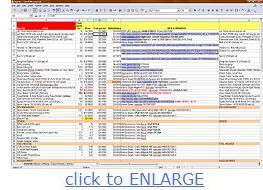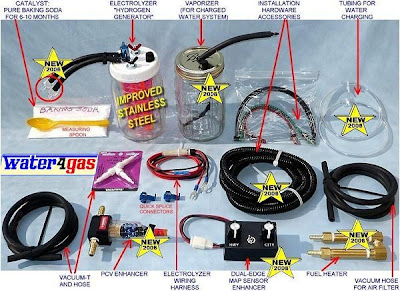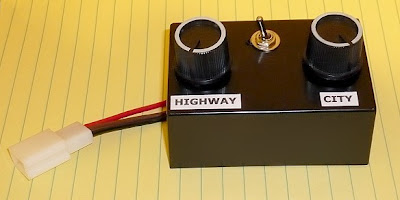What have we learned so far?
- What YOU can do about insane gas prices
- Basic Principles of Water, Hydrogen and Oxygen
- Is it possible to generate Free Energy in YOUR car/truck?
- How much you can save – and how
- We looked at a simple & affordable system
- Does it work? Is it dangerous?
- Engine and computer modifications not required
- Costs & Maintenance
- Warranty protection.
What we did NOT learn: Gas Saving Techniques!
After extensive of research, I have come to the conclusion that Water4Gas technology would not be complete without GST's - Gas Saving Techniques. I collected many ideas and claims, then set forward to TEST each one. My concern was: what GST works WITH WATER4GAS, and what doesn't.
The result of my experimentation was a long list of techniques, formulas and tips on how to use Water4Gas technology to MAXIMIZE GAS ECONOMY. All the successful GST's are detailed in my second book titled "How to Save Tons of Fuel With Your Hydrogen-On-Demand System".
Where to get parts
 With the e-books you will find links to a COMPLETE LIST of parts, all in one place and with SHIPPING COSTS calculated; even with space for inventory control. You're going to get the logistics data ("logistics" means calculation and control of supplies, shipping, etc.) for manufacturing of kits, devices and systems.
With the e-books you will find links to a COMPLETE LIST of parts, all in one place and with SHIPPING COSTS calculated; even with space for inventory control. You're going to get the logistics data ("logistics" means calculation and control of supplies, shipping, etc.) for manufacturing of kits, devices and systems.
The data comes as a large spreadsheet (calculation table), see picture >>>
You'll also get a FREE software that opens this spreadsheet.
Where to get ready-made systems
Once you place your order for the books you will be able to do one or both of the following:
- Learn how to build this system yourself,
- Have one of our friends around the world build a COMPLETE READY-TO-INSTALL SYSTEM for you.
You will get access to our readers-only marketplace where you can shop between great offers as low as $45 for the Electrolyzer (HHO Generator)! The marketplace is organized by country & state, category and price range, to help you find a seller or installer near you - and within your budget!
The reasons you're required to purchase the e-books in order to access the vendors list: the e-books are VITAL - we found out that owning a system in a box is not enough to get results - which would give our technology a bad name.
I don’t want you to be frustrated with your technology. I want you to have all the benefits it can give you, so you can be very happy with it. You definitely need the education provided in these e-books - and that's why we have bundled them together with the Marketplace access. However the Marketplace is a free service to our readers! To keep prices down and enable fast growth, we do NOT take any fees from buyers OR sellers in the Marketplace.
With this arrangement, you can enjoy both the comfort of shopping between many offers and finding the one that's best for you, as well as enjoying the full benefits of our technology.
Where to find installers
- Go to YOUR mechanic. He knows you, he knows your car or truck.
- Give him the installation chapter and ask him to do the installation for you.
- You'll usually find out: once the mechanic sees how simple is the installation and he sees that the instructions are all laid out with many photos and diagrams, he will probably be glad to learn a new system and do this for you.
- Cost of installation usually run $100, but depend on the complexity of the car or truck. Trucks installations are sometimes simpler because there is more hood under the hood.
- In case any maintenance is required, it would be easier for you to go to your local mechanic for future service.
Where does this lead?
We MUST think of others, our children, and our future generations. We MUST carefully consider whether our choices will have a negative impact upon them. If we do not, then we are no better than those that are raping us with our energy addiction. We really need to break free of the selfish mindsets that put our wants and desires ahead of others well-being.
~Bob Boyce, June 2007
Bill Lang of Gulf Laboratories, the original developers of  technology, says: "The period of suppression is OVER!" and he then quotes Tesla saying:
technology, says: "The period of suppression is OVER!" and he then quotes Tesla saying:
“To an extent this long period of unproductiveness can be explained. Learning was the privilege of a few and all information was jealously guarded. Communication was difficult and slow and a mutual understanding between widely separated investigators hard to reach.”
~Nicholas Tesla: The Fairy Tale Of Electricity, 1915
The advent of the Internet has made this technology unstoppable. Also I must tell you that competition is GOOD, actually VERY GOOD for all of us. That's because the academic institutions and auto makers alike have been feeding us false information. We were led to believe that using water for energy was impossible. Now the secret is out - it is (1) very possible, and (2) it is Public Domain, which means you own this technology and can drive it right now without waiting and without paying extortionate fees to anybody.
Bottom line: change is inevitable. We're going to see many more small and large manufacturers, installers in every city, and many 1000's of drivers and fleet managers exchanging notes and supporting each other in the quest for cheaper energy.
I expect the biggest and fastest change to come from the truckers - that's why I started  after the fabulous success of Carter Blankenship III from Blankenship Trucking. You have to realize how strong is the GROUP DYNAMIC between truckers - they are going to spread the word faster than wildfire, for the benefit of truckers and car drivers as well.
after the fabulous success of Carter Blankenship III from Blankenship Trucking. You have to realize how strong is the GROUP DYNAMIC between truckers - they are going to spread the word faster than wildfire, for the benefit of truckers and car drivers as well.
Click Here for More Information
Yours Sincerely
David Jackson















